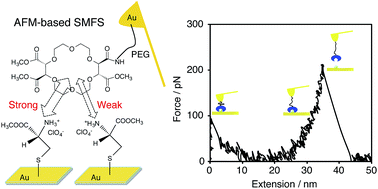Single-molecule force spectroscopic study on chiral recognition of cysteine derivatives immobilized on a gold substrate by using AFM tips chemically modified with optically active crown ethers†
Abstract
The chiral recognition of cysteine derivatives immobilized on a gold substrate using atomic force microscopy (AFM) tips chemically modified with optically active crown ethers was quantitatively investigated with single-molecule force spectroscopy (SMFS). Interestingly, the chiral recognition ability of the optically active crown ether-modified tip was entirely opposite to that of its optical isomer-modified tip. The difference of rupture forces for the chiral recognition was determined to be about 40 pN under our experimental conditions.


 Please wait while we load your content...
Please wait while we load your content...